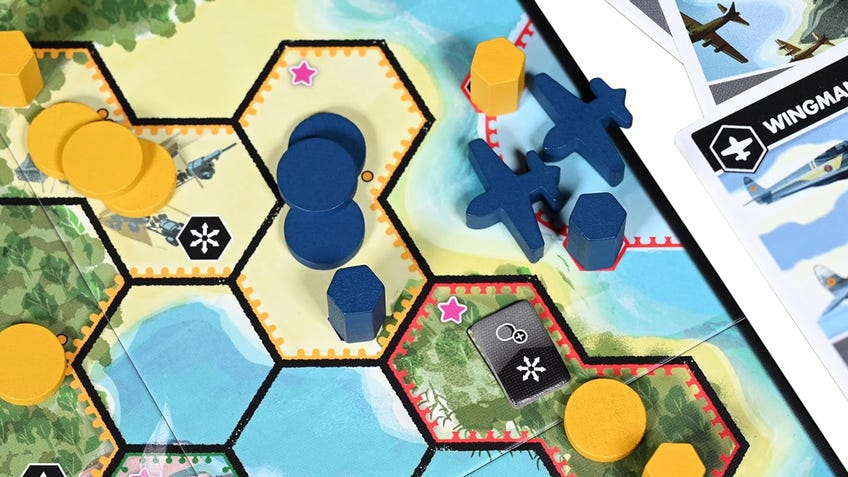10 best two-player board games
When three's a crowd.
Organising a large group of people can be more troublesome than it’s worth, which is why it’s a good idea to have a staple of the best two-player board games on hand.
Best two-player board games
- Jaipur
- Corinth
- Patchwork
- Klask
- Wingspan: Asia
- Sobek: 2 Players
- Jekyll vs. Hyde
- 7 Wonders Duel
- Lost Cities
- General Orders: World War II
It’s a heck of a lot easier to find just one other person to play with you: whether it’s your partner, a friend or family member. However, it’s not enough just to have some board games that support two players as they’re sometimes better designed for a larger group. Which is why our list of the best two-player board games mainly features titles that are specifically intended to be played by a maximum of two people.
Board games that are designed to be played by just two people often ensure a more intense, intimate and competitive experience - displaying exactly why there’s something inherently special about playing as a duo.
Whether you’re looking for a fast-moving card game, a wholesome tile-laying experience or an intense strategic affair, this list features options for pretty much every mood. There’s also a wide variety of themes covered here - from wildlife to Ancient Egypt to gothic horror - meaning that there’s something for everyone. Don’t settle for second best and check out the best two-player board games you can try right now!
1. Jaipur
A fast-moving card game about trading and camels
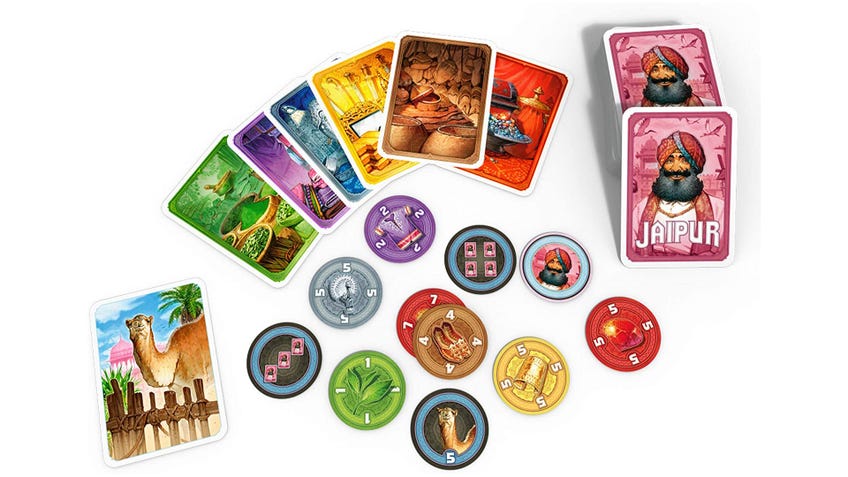
There are plenty of two-player card games out there, but Jaipur stands out as one of the greatest. A game about trading, Jaipur encourages its players to indulge in their more competitive sides, stealing victory from right under their opponent’s nose. As rival merchants working for the maharaja, the players are attempting to impress by pulling off some of the sweetest deals they can. Each round has players purchasing various goods from the market, before selling them off in bulk afterwards. The more they’re able to sell at once, the more points they’ll earn. However, players will need to move quickly if they want to stay ahead of their opponent.
On their turn, a player can choose to take a single card from the market or exchange any number of cards from their hand for the same number of cards from the market. The cards they take must be of the same type, which certainly helps when players are trying to collect as many matching cards as possible. Once players have at least three cards of the same type, they can sell them to acquire the same amount of matching point tokens. The higher value point tokens of each type are kept at the top of the stack, meaning that players who sell earlier gain more points.
On the other hand, holding out for more cards to sell at once grants players a bonus token that will be worth a random amount of points, with the more valuable tokens going to the larger sales. There are only a set number of each type of card, with rarer cards providing more valuable tokens, meaning that players can end up fighting over certain types and it can get nasty. Nothing is more devastating than seeing a card of the type you’re collecting being taken by your opponent. Luckily enough, Jaipur is fast moving game that will fire you up enough to want you to play again right away.
Buy Jaipur on Amazon UK and Amazon US
2. Corinth
A roll-and-write gem that’s perfect for two
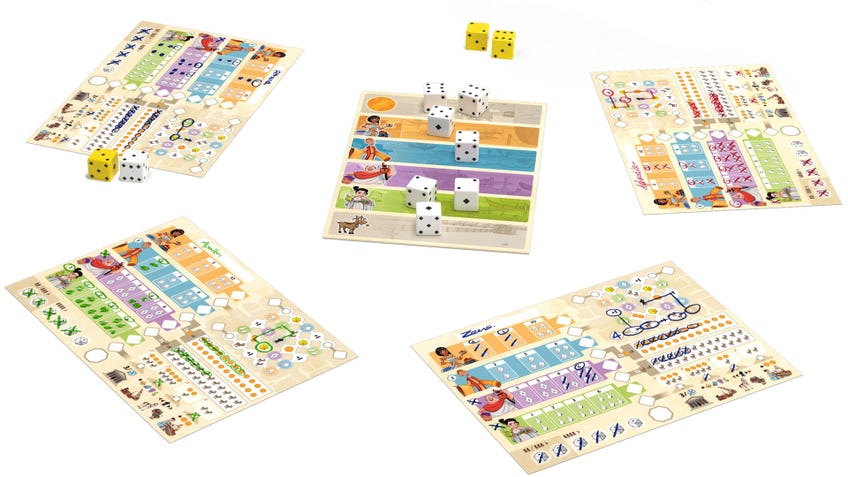
While many roll-and-writes see players effectively playing separate games side-by-side with little direct interaction, Corinth adds a more direct element of competition to its box-ticking points fest. Players claim dice from a central board, using the results to gain gold and goods or activate various other effects as they look to trade their wares to market stands and construct new buildings. Dice can also be used to wander your steward around a separate grid, gaining extra points and goods.
Corinth will be familiar to some for being a remake of Yspahan: The Dice Game - itself a spin-off from designer Sébastien Pauchon’s 2006 Spiel des Jahres-nominated dice-drafting game. Even those who haven’t played Yspahan will find many elements familiar; this is a game that excels for being a comfortable version of what’s come before, rather than anything groundbreaking by itself.
That’s not to understate just how pleasant Corinth is to play, mind. With a relatively small pool of six actions branching into a spiderweb of scoring routes and options on your turn, there’s plenty to think about even in the game’s relatively short 20-minute playtime. The more interactive dice-drafting mechanics add an extra level of head-to-head rivalry to the satisfying roll-and-write engine underneath, making this perfect for small groups or even just two players looking to fill a lunchtime or spare moment between bigger games. With such easy rules, it's also ideal for board game beginners, too.
Packed up in a portable box and with lovely art and production in its dice, Corinth is a delightfully light roll-and-write that you shouldn’t overlook.
Buy Corinth from Zatu UK and Amazon US
3. Patchwork
An incredibly wholesome and fun little game about quilting
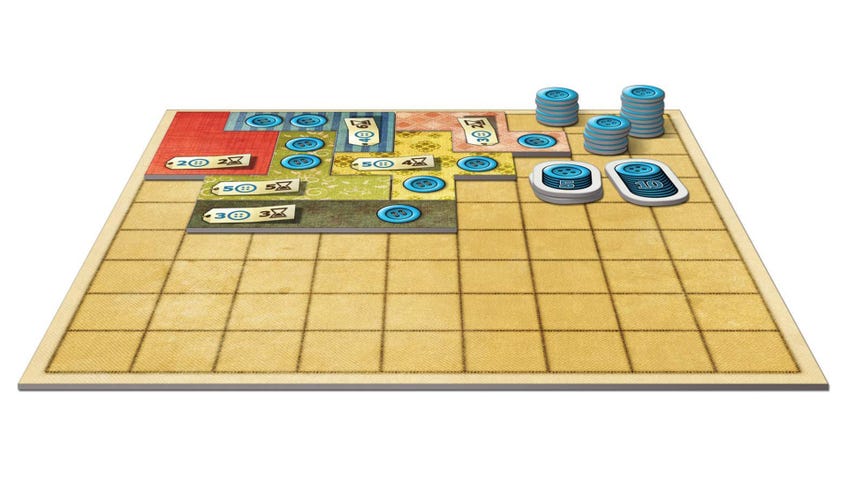
When it’s raining outside and all you want to do is curl up inside, all cozy-like, there’s nothing better than an intimate board gaming session. Days like this call for Patchwork, a board game for two players that’s about as charming as a corgi wearing a very small hat. Using the various trimmings you’ve acquired over the years, you must piece together a quilt – making sure to utilise as much space as possible and, obviously, scoring as many points as you can.
Each player gets their very own board, with the various quilt pieces being laid out in a circle, with each piece needing to be placed next to each other in a direct line so that they form an orderly queue. This is your selection of fabrics, with the pieces greatly varying in size and shape. Covering as much of your board as possible is important, as you’ll be punished for every empty square at the end of the game. On their turn, a player can obtain a quilt piece. If players do not have any buttons to buy a quilt piece or don’t want to buy anything, then they can choose to move their player token along the turn track to gain buttons equal to the number of spaces they move.
Another way of gaining buttons in Patchwork is to place quilt pieces displaying buttons onto your player board. Anytime a player token passes or lands on one of these button spaces both players gain as many buttons as they have currently on their player board. You’ll eventually get into the rhythm of choosing and placing quilt pieces on your board, maximising the amount of space they cover and being sure to pick some with buttons on. For a challenging and yet undeniably relaxing two-player board game, why not get wrapped up in a little Patchwork?
Buy Patchwork on Amazon UK and Amazon US
4. Klask
Air hockey plus magnets equals this fast-paced two-player game
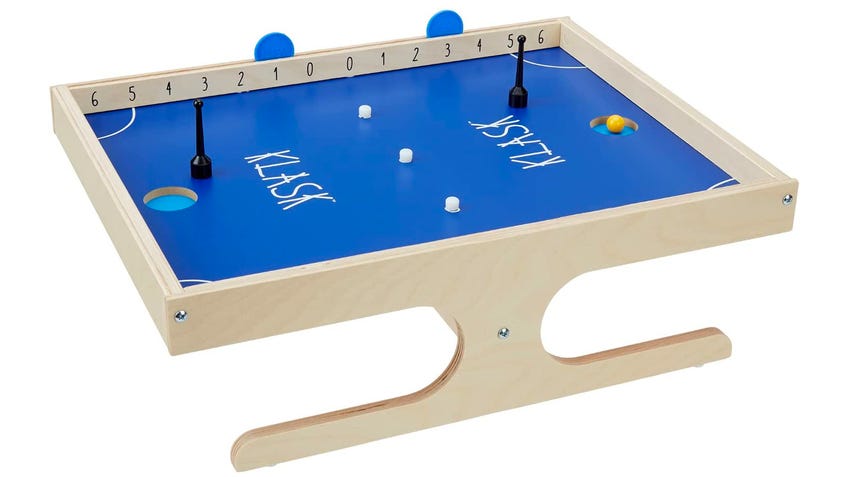
Created by Danish carpenter Mikkel Bertelsen one hungover morning, Klask is fittingly the perfect two-player game to enjoy over a couple of cold ones with friends.
The modern offspring of pub fixtures such as air hockey and table football, but with the addition of magnets, Klask – a Danish word for “smack!” - is a crowdpleasing head-to-head competition that plays out in a self-contained miniature wooden pitch.
Each player controls an air hockey-like pusher to knock a ball around the pitch – except, rather than moving the plastic pieces directly with their hands, they control them from underneath the board using a strong magnet.
This magnet amps up the tension of getting one over on your opponent, as players must stop the ball from going in their goal – a circular pit in the board – but also avoid getting their own magnetic piece stuck in the hole, often accompanied by the game’s signature “SMACK!”
Further obstacles come in the form of small white magnets that lie along the pitch’s halfway line, which will stick to a player’s magnet if it wanders too close – or can even be propelled towards your rival with a careful shot. Falling into your own hole or getting two of the magnets stuck to you also concedes a point, so it’s not all about shooting for goal.
Klask’s simple rules and intense, lightning-fast gameplay make it an outstanding two-player board game, but it’s the kind of game that naturally gathers a crowd and makes for fun mini-tournaments – so keeping it to just two players may be a difficult task! The original game for two players has since expanded into a four-player version, but we’d argue that the original two-player is still the best way to experience this utterly unique gem.
Buy Klask on Amazon UK and klaskyourway.com
5. Wingspan: Asia
A two-player version of the popular bird befriending board game

The original Wingspan is a board game for up to five players about attracting a variety of birdlife to players’ habitats. Wingspan: Asia is both an expansion for that game and its own separate two-player title, so you don’t need to own the original Wingspan to play it.
As the name suggests, it revolves around types of birds found across the Asian continent - whilst the core Wingspan only features birds that are native to North America - with players attempting to cultivate an attractive environment for the avian animals to make their nests in. As in the original game, players take turns to perform one of four actions: playing a bird card, gaining food, laying eggs and drawing bird cards. Doing these actions will eventually lead to players scoring points at the end of each round and when the game ends through the value of their bird cards, the number of eggs they have and whether they’ve fulfilled any secret objectives.
How Asia differs is through a board shared by both players. This shared board allows players to place tokens along a network and gain additional points by completing the round scoring requirements featured on the board. Whenever players play a bird card onto their individual boards, they’ll be free to put a token on a space on the shared board as long as: the bird they’ve played fits the space’s rule and it is adjacent to another of their tokens, unless it’s the first one they’re placing.
The shared board turns original Wingspan - which is mostly a board game where players keep to themselves - into a more intense and competitive experience, with players racing to get what they need to play the cards required to place another token where they want on the shared board. If you want an accelerated and intensified version of Wingspan, or just a two-player game about birds, then Wingspan: Asia is ideal.
Buy Wingspan: Asia from Amazon UK and Amazon US
6. Sobek: 2 Players
Buy low and sell high in this tense set-collection board game
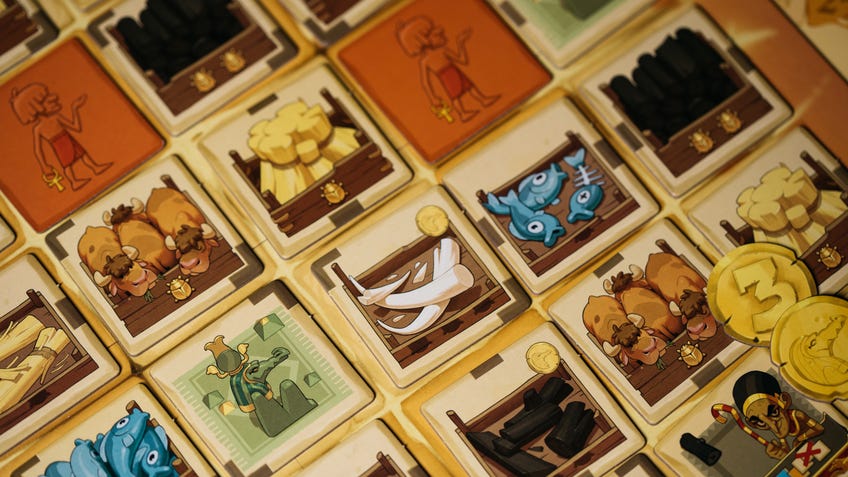
The original Sobek supported up to four players but its recent remake has made the bold decision to reduce the player-count to just two. Though this move does exclude larger groups from playing, it was most definitely the right one when it comes to making the most of Sobek’s gameplay. Sobek: 2 Players takes the basic premise of the 2010 original – gathering and trading in items to make the most wealth possible – and turns it into a tense two-player standoff in which only the meanest thrive.
As merchants looking to make a fortune in the markets of ancient Egypt, players will need to collect matching tiles before selling them off in the largest bundle they can gather. Besides the number of tiles, players will also be looking to collect tiles which have the highest number of scarab beetles on them – as these will net them more gold than others. In order to gain tiles, players will take turns to choose one tile from a shared grid. Which tile they can take will depend on what direction the golden ankh is pointing in, with players restricted to take a tile from the line designated by the ankh. However, for every tile between the ankh and the chosen tile, players will need to take an amount of corruption: which turns into minus points at the end of the game.
This means that taking a tile you really want may require a sacrifice of taking corruption – but it could be worth it for all the points you’ll gain. Players can also take tiles to deliberately set the ankh up for future turn, whether to benefit them or punish their opponent. There are also ways to move or change the direction of the ankh without having to take a tile, thereby enabling even more opportunities to be crafty. Sobek: 2 Players is a perfect example of how an older, less-remembered game can be transformed into a really special two-player experience.
Buy Sobek: 2 Players from Zatu UK and Amazon US.
7. Jekyll vs. Hyde
Grapple against your opponent in a classic literary battle of wills
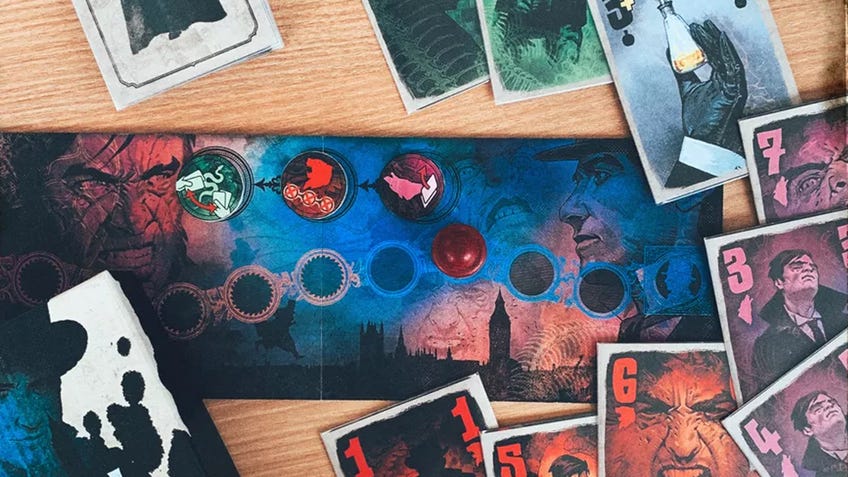
Based on the classic book The Strange Case of Dr Jekyll and Mr Hyde by Robert Louis Stevenson, Jekyll vs. Hyde sees two players duke it out as either the misguided doctor or vicious criminal. This battle of wills has been translated into a card game played over three rounds. Each player’s progress towards their respective goals is depicted via a shared board featuring a token that represents how much control Dr Jekyll has relinquished to his sinister counterpart. Whilst the Mr Hyde player wants to move this token to the far left of the identity track as quickly as possible, their opponent wants to reach the end of the third round before this happens.
Whether the token moves or not is determined by the score of each round. Every round is played through a series of ‘tricks’ or exchanges of cards between the two players. When one player lays down a card, the other will have to place a card of the same suit - unless they don’t have any matching cards left. Whichever player has the highest numbered card wins that trick. Players can use unique cards to try and force a certain outcome for a trick - whether that’s a win or a loss for them.
Jekyll vs. Hyde isn’t about winning every trick, instead the Hyde player will want to ensure that there is as big a difference as possible between the players’ scores by the end of each round, whilst the Jekyll player will want there to be more of a balance. This is because the token on the shared board will move based on the difference between the players’ score. For example, if the scores are three and seven then the token will move four spaces to the left.
This gameplay mechanic means that players will want to alter the pacing and flow of the game to suit their objectives, not necessarily just to win every trick - which makes Jekyll vs. Hyde an exciting and intense card game wherein no one round is like the other.
Buy Jekyll vs. Hyde from Amazon UK and Amazon US
8. 7 Wonders Duel
The beloved civ-building card game for two players
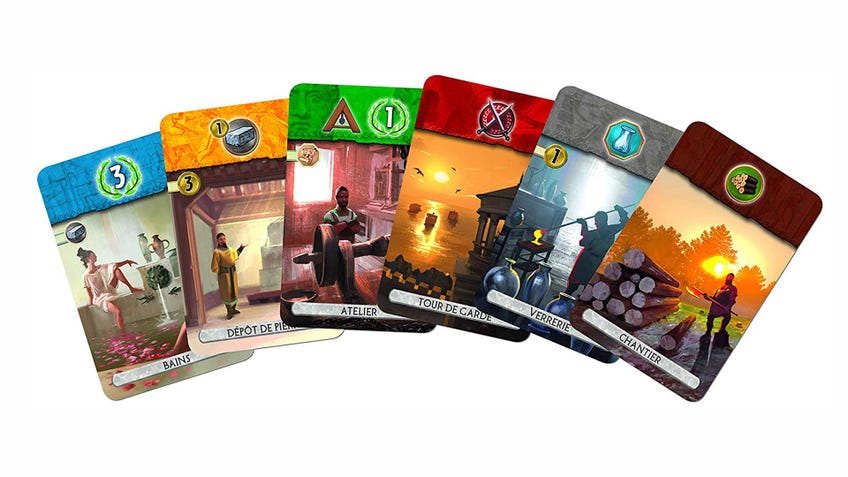
The original 7 Wonders is considered by many one of the best board games of all time. Taking the epic theme of leading a civilisation through the ages but playing out in well under an hour, 7 Wonders found the perfect balance between the deep strategy of developing your technology, culture, science and more, and the simplicity of only having to pick a single card and do what it says each turn.
7 Wonders Duel takes 7 Wonders and pares it down even further, making it a board game for two players only. (7 Wonders technically has rules for two players, but they’re not the best way to play if there’s just two of you.)
Rather than passing cards around the table, in 7 Wonders Duel the two players pick from the middle of the table, having to choose from cards that have been uncovered in earlier turns. As they gather precious resources, the players can even build wonders – yes, like those Wonders – that help their civ grow further.
The thrust of the two-player board game remains largely the same, as the players race to develop their civilisation faster than their opponent – looking to claim victory through scientific breakthroughs, military might or overall advancement. 7 Wonders Duel plays just as fast – if not faster – than its bigger sibling, making it the perfect two-player game to break out with a friend or partner.
7 Wonders was a brilliant board game, and 7 Wonders Duel easily lives up to its legacy as one of the best board games for two people. It’s a whirlwind trip through history in a small, quick card game that’s easy to learn and fun time after time to play. One of the wonders of the board game world? Maybe...
Buy 7 Wonders Duel on Amazon UK and Amazon US
9. Lost Cities
Explore ancient ruins in the hopes of uncovering amazing discoveries
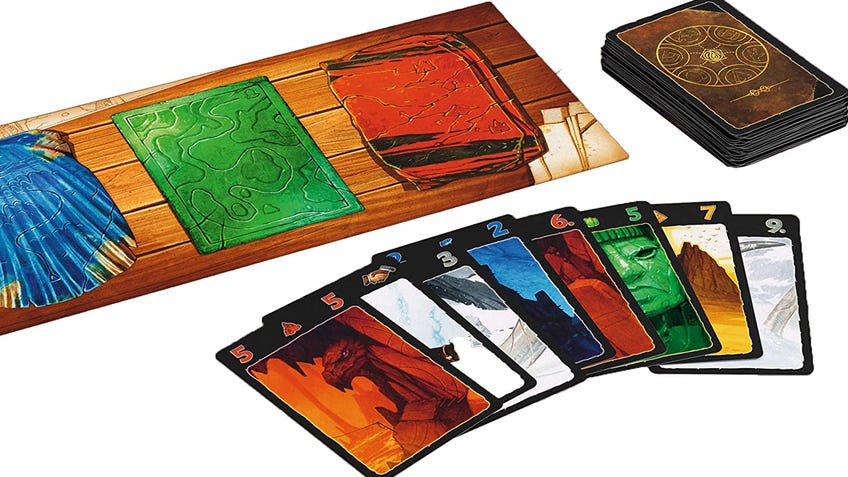
Lost Cities is considered an absolute classic and one of legendary designer Reiner Knizia’s best. As rival archeologists, both players in Lost Cities plan and embark on expeditions at the same time, substantially increasing the stakes. The reputations, and potentially even careers, of each archaeologist are on the line, with the goal of successful exploration in their sights. These expeditions are represented by columns of numbered cards which players will need to lay down in numerical order. However, players don’t necessarily need to play cards consecutively, just higher-numbered cards on top of lower-numbered ones. But the more cards played onto an expedition the better, as they’ll gain players a greater number of points at the end of the game.
Choosing to begin an expedition is not a decision to be made lightly, as you’ll be scored on all your columns, regardless of how many cards you’ve placed there. Travelling around the world with an entire team costs a lot of money, which is why the score for every expedition you start begins at minus-20 points. This means that players need to place cards of a total value of at least 20 in order to not score minus points. What’s more is that playing special handshake cards onto an expedition will multiply its score total, which also applies to minus totals. This means you’ll have to be sure you’re going to be able to lay down enough cards on an expedition to avoid that minus point penalty.
This is what makes Lost Cities so exciting and intense. Players share the same deck of cards, meaning that they both draw from the same pile. You’ll spend most of the game praying that you’ll draw the cards you need to pass that minus-20 total, otherwise you’ll quickly regret your past decisions as you watch your expeditions drain your points. For a game of high risk and high reward, crack open a copy of Lost Cities.
Buy Lost Cities on Amazon UK and Amazon US
10. General Orders: World War II
Get stuck into a tug of war in a pivotal Second World War battle
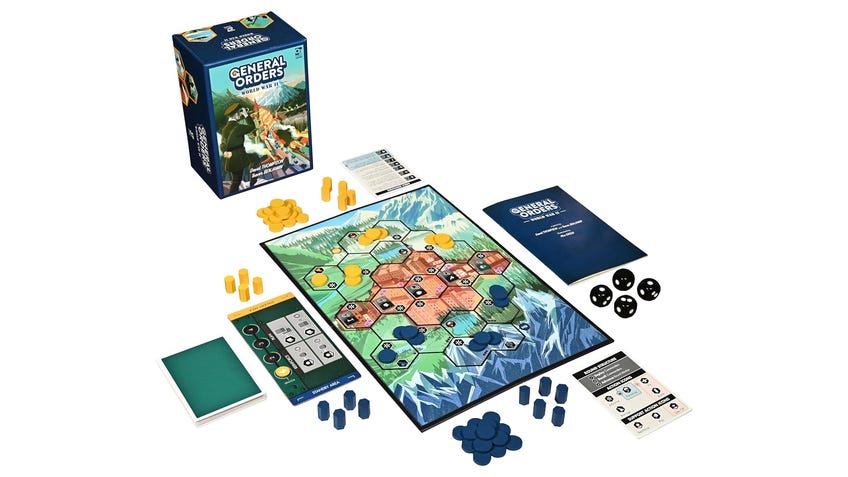
Co-designed by the creators behind the fantastic Undaunted series, General Orders: World War II is a little like a streamlined version of Warhammer 40K if it was themed around historical warfare instead of dark sci-fi. As commanders of opposing armies in a battle spread across the Italian mountains, players will be attempting to breach the far side of their opponent’s half of the game board first. Players can do this by strategically advancing across the board: destroying their enemy’s defences, cutting off their supply lines and standing their ground.
Players begin the World War II board game by placing a number of their units - represented by simple blue or yellow tokens - onto spaces on their side of the board. Players then take turns to either play cards or perform certain actions such as placing additional troops, moving units and engaging in fights. Whenever a player moves or places a token onto the same space as an opposing player’s unit/s, they instigate a fight - rolling a certain number of dice depending on how many troops each person has. Rolling hits will take out an opponent’s unit/s and secure the space for the victor.
Players might also have other strategic options available to them - such as barrages and aerial bombers - depending on the kind of cards they have access to. Using these, alongside their standard collection of troops, players will need to outsmart their opponent in order to march closer to their goal. Meanwhile, the opposing player will need to respond to their enemy’s advancement and enact counter-attacks to win the battle back in their favour.
Besides the Italian mountains map, players will also be able to play the more complex Pacific islands map found on the other side of the game board - if they’re feeling more confident about their understanding of the game.
For players who want a competitive wargaming experience with the cost and heaviness of something like Warhammer 40K, then General Orders: World War II is an excellent alternative.
Buy General Orders: World War II from Amazon UK and Amazon US
